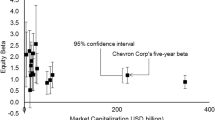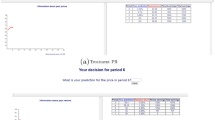Abstract
This paper investigates how market participants form risk perspectives through a sequence of information shocks. Guided by a theoretical Bayesian learning model, we exploit a natural experiment afforded by the fracking boom in Pennsylvania in the late-2000s. We empirically examine whether familiarity with historical conventional gas explorations affects the willingness to pay for houses near fracking wells. We find the local real estate market is very efficient with participants rapidly collecting and processing market–relevant new information. We also find that participants discount historical events and rely on current information to estimate the risk of a change in market conditions.







Similar content being viewed by others
Notes
Gold, Russell and Tom McGinty, “Energy Boom Puts Wells in America’s Backyards” The Wall Street Journal, October 25, 2013.
“Fracking: So where’s the economic boom that was promised?” https://www.dispatch.com/article/20140128/NEWS/301289852
See Viscusi et al. (1997) for a more general discussion of the Bayesian learning model.
Although there are approximately 1700 Zip Codes tabulation areas in PA as of 2018, approximately 55% of the housing stock in PA are in those 200 Zip Codes. “2010 Census of Population and Housing” https://www.census.gov/prod/cen2010/cph-2-40.pdf.
We report the annualized gain as the monthly gain multiplied by twelve months. Monthly gains are estimated by taking the sum of the corresponding base term coefficients, the interaction term coefficients, and multiplying the net return by the median house price in our data ($209,800).
The median sale prices in this sample is 158.89 thousand dollars.
For example, one of the accidents has the following description in the DEP report: “The well erupted late Tuesday, sending thousands of gallons of chemical-laced and highly saline water spilling from the drill site, heading over containment berms, racing toward a tributary of a popular trout-fishing stream and forcing seven families nearby to temporarily evacuate their homes.”
Conventional selection criteria (AIC, HBIC, and SBIC) suggest that the most appropriate number of lag months is zero. Standard errors are calculated using two-way clustering by county–year.
We also tested several alternative models control for county-level household income, the count of fracking wells in a Zip Code, the AGI and Wage and Salary Income. None of those additional specifications drastically altering the results reported in the current Table 6. Results from the alternative specifications are available upon request.
The model specifications used to produce Column (1)-(2) corresponds to those in Column (1) Table 4 because local characteristics data at the Zip Code level are not available for this period.
References
Admati, A.R. (1985). Information in financial markets: the rational expectations approach. Graduate School of Business, Stanford University.
Agarwal, S., Driscoll, J.C., Gabaix, X., & Laibson, D. (2008). Learning in the credit card market.
Agarwal, S., Driscoll, J.C., Gabaix, X., & Laibson, D. (2009). The age of reason: Financial decisions over the life cycle and implications for regulation. Brookings Papers on Economic Activity, 2009(2), 51–117.
Balthrop, A.T., & Hawley, Z. (2017). I can hear my neighbors’ fracking: The effect of natural gas production on housing values in tarrant county, tx. Energy Economics, 61, 351–362.
Clapp, J.M., Nanda, A., & Ross, S.L. (2008). Which school attributes matter? the influence of school district performance and demographic composition on property values. Journal of urban Economics, 63(2), 451–466.
Cunningham, C., Gerardi, K., & Shen, L. (2020). The double trigger for mortgage default. Evidence from the fracking boom. Management Science. forthcoming.
Davis, L.W. (2004). The effect of health risk on housing values: Evidence from a cancer cluster. American Economic Review, 94(5), 1693–1704.
Dumm, R.E., Sirmans, G.S., & Smersh, G.T. (2018). Sinkholes and residential property prices: Presence, proximity, and density. Journal of Real Estate Research, 40(1), 41–68.
Gallagher, J. (2014). Learning about an infrequent event: evidence from flood insurance take-up in the united states. American Economic Journal: Applied Economics, 206–233.
Gallagher, R.M., & Persky, J. (2020). Heterogeneity of birth-state effects on internal migration. Journal of Regional Science.
Gatzlaff, D., McCullough, K., Medders, L., & Nyce, C.M. (2018). The impact of hurricane mitigation features and inspection information on house prices. The Journal of Real Estate Finance and Economics, 57(4), 566–591.
Grossman, S.J., & Stiglitz, J.E. (1976). Information and competitive price systems. The American Economic Review, 246–253.
Hansen, J.L., Benson, E.D., & Hagen, D.A. (2006). Environmental hazards and residential property values: Evidence from a major pipeline event. Land Economics, 82(4), 529–541.
Kahneman, D., & Tversky, A. (2013). Prospect theory: An analysis of decision under risk. In Handbook of the fundamentals of financial decision making: Part I. World Scientific (pp. 99–127).
Kai-Ineman, D., & Tversky, A. (1979). Prospect theory: An analysis of decision under risk. Econometrica, 47(2), 363–391.
Kiel, K.A., & McClain, K.T. (1995). The effect of an incinerator siting on housing appreciation rates. Journal of Urban Economics, 37(3), 311–323.
Kiel, K.A., & Williams, M. (2007). The impact of superfund sites on local property values: Are all sites the same? Journal of urban Economics, 61(1), 170–192.
Klaiber, H.A., & Gopalakrishnan, S. (2012). The impact of shale exploration on housing values in pennsylvania.
Kohlhase, J.E. (1991). The impact of toxic waste sites on housing values. Journal of urban Economics, 30(1), 1–26.
Kousky, C. (2010). Learning from extreme events: Risk perceptions after the flood. Land Economics, 86(3), 395–422.
Leggett, C.G., & Bockstael, N.E. (2000). Evidence of the effects of water quality on residential land prices. Journal of Environmental Economics and Management, 39(2), 121–144.
Ling, D.C., Lu, Y., & Ray, S. (2018). How do personal real estate transactions affect productivity and risk taking? evidence from professional asset managers. Real Estate Economics.
Malmendier, U., & Nagel, S. (2011). Depression babies: do macroeconomic experiences affect risk taking? The Quarterly Journal of Economics, 126(1), 373–416.
Malmendier, U., & Nagel, S. (2015). Learning from inflation experiences. The Quarterly Journal of Economics, 131(1), 53–87.
Muehlenbachs, L., Spiller, E., & Timmins, C. (2012). Shale gas development and property values. Differences across drinking water sources.
Muehlenbachs, L., Spiller, E., & Timmins, C. (2015). The housing market impacts of shale gas development. American Economic Review, 105 (12), 3633–59.
Nicolosi, G., Peng, L., & Zhu, N. (2009). Do individual investors learn from their trading experience? Journal of Financial Markets, 12(2), 317–336.
Pope, J.C. (2008a). Buyer information and the hedonic: the impact of a seller disclosure on the implicit price for airport noise. Journal of Urban Economics, 63(2), 498–516.
Pope, J.C. (2008b). Do seller disclosures affect property values? buyer information and the hedonic model. Land Economics, 84(4), 551–572.
Pope, J.C. (2008c). Fear of crime and housing prices: Household reactions to sex offender registries. Journal of Urban Economics, 64(3), 601–614.
Shiller, R.J. (1991). Arithmetic repeat sales price estimators. Journal of Housing Economics, 1(1), 110–126.
Van Nieuwerburgh, S., & Veldkamp, L. (2009). Information immobility and the home bias puzzle. The Journal of Finance, 64(3), 1187–1215.
Viscusi, W., Hakes, J., & Carlin, A. (1997). Measures of mortality risks. Journal of Risk and Uncertainty, 14(3), 213–233.
Viscusi, W.K. (1991). Age variations in risk perceptions and smoking decisions. The Review of Economics and Statistics, 577–588.
Viscusi, W.K. (1992). Fatal tradeoffs. Public and private responsibilities for risk. New York: Oxford University Press.
Acknowledgements
We thank Kun Bi, Chris Cunningham, Kris Gerardi, and seminar participants at the 2020 FSU-UF-UCF Real Estate Symposium, the Pennsylvania State University, the American Real Estate Society’s 33rd Annual Meeting, the 2016 Southern Finance Association annual meeting, and the 2018 Energy and Commodity Finance Conference for their helpful comments and discussions. We sincerely thank the helpful comments made by our anonymous referees. Special thanks to Gary Frederick for providing background information about the PA real estate market during the study period. All errors are our own.
Author information
Authors and Affiliations
Corresponding author
Additional information
Publisher’s Note
Springer Nature remains neutral with regard to jurisdictional claims in published maps and institutional affiliations.
Rights and permissions
About this article
Cite this article
Ambrose, B.W., Shen, L. Past Experiences and Investment Decisions: Evidence from Real Estate Markets. J Real Estate Finan Econ 66, 300–326 (2023). https://doi.org/10.1007/s11146-021-09844-2
Accepted:
Published:
Issue Date:
DOI: https://doi.org/10.1007/s11146-021-09844-2




